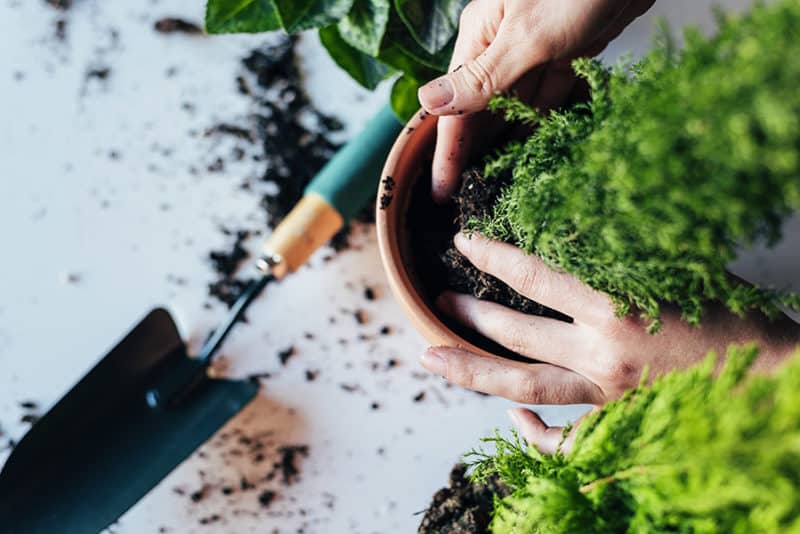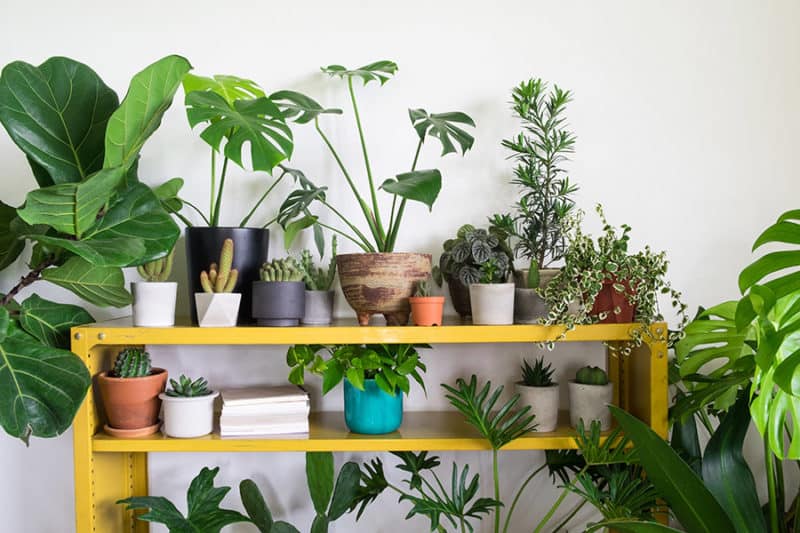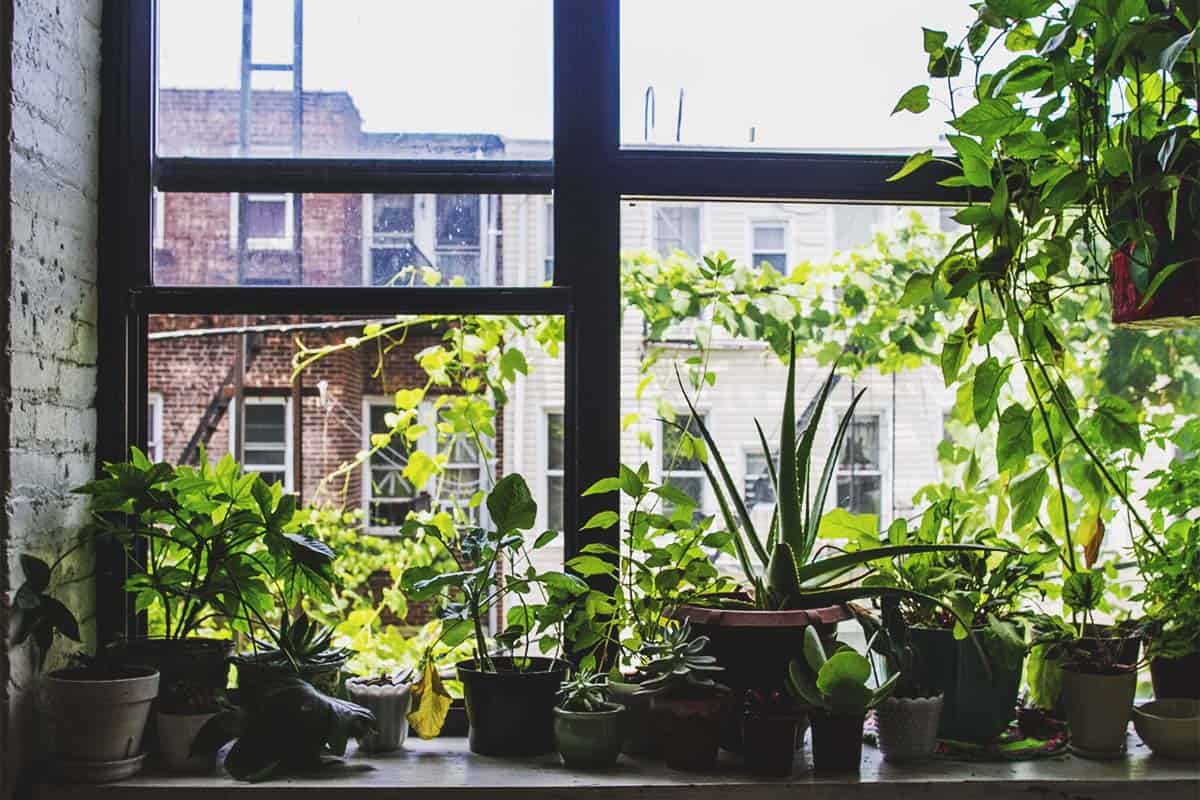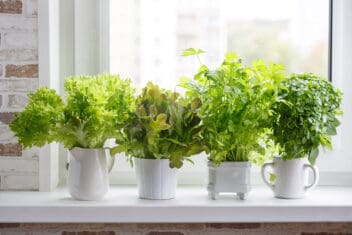Each year as fall arrives and the temperature starts to dip, I’m left with a porch full of potted plants that I’m not sure what to do with. My usual strategy is to pull anything that’s beginning to wilt and store the pot for the winter.
But what about the plants that are guaranteed to die if left exposed to the cold? What do you do with those tender plants? Sure, you could leave them to die as soon as the rain turns to ice and snow begins to fall.
But what about all that time you spent nurturing the plants? Did you spend money on a tropical palm for your summer patio oasis? Don’t let that time and money go to waste! Bring that plant inside over the winter and enjoy it again once the chance of frost has passed in the spring.
Timing
Wintering plants indoors sounds easy enough, right? The first thing to keep in mind is timing. Don’t wait too long before transporting your healthy outdoor potted plants inside. Waiting an extra day and letting that plant sit out in the cold is a potential killer. Keep your eye on the weather and bring any plants you wish to overwinter inside sooner rather than later.
For tropical plants, an unexpected dip in temperature can spell disaster and leave you with a plant in poor health. Overwintering plants in lousy shape is more of a chore than anything else, so bring plants indoors as soon as you have space to house them.
Prepping Plants for Indoors
It sounds easy. Bring the pot inside, keep the tender plant warm, and wait it out until the spring. There are, however, a few additional steps required in many cases.
Re-pot Your Plant

Your plant has likely grown significantly over the summer. The sunny weather, ideal growing conditions, and tender love and care have allowed it to thrive. Before stationing the potted plant in your living room, it may be time to re-pot it into a larger container.
If so, choose a vessel a few inches larger in diameter than the previous one. People have different opinions about re-potting at this time of year, however. I myself prefer to re-pot anything in the spring to minimize stress. The spring is a time when I do all of my seed starting and planting, so why not save this extra work until then?
Assess and Treat
When re-potting, assess the plant for insect activity and disease. If there are signs of insects on the foliage, use a homemade spray or neem oil to rid the plant of any infestation and prevent the spread of insects to other indoor plants.
Clean Up Plants
Clean off plants with a burst of water from the hose before bringing them inside. Let the plant air dry and then place them in their temporary indoor home.
Remove damaged and dead foliage with sanitized tools, clean the topsoil by eliminating any debris. Don’t heavily prune these plants as it’s likely to stress them as they enter their rest period. Clean the exterior of plant pots that have been outside. A quick wipe is fine if you plan to use hide-a-pots indoors.
Find the Right Location
Create a spot for your new indoor plant by moving furniture or other items out of the way. Even though it’ll need less water in the winter, you’ll still have to water your plant while it’s indoors, so be sure that there’s a saucer or other water-catcher of some kind to prevent moisture from seeping onto your carpet or hardwood floors.

If you lack the floor space to sacrifice to overwintering plants, try to find vertical space, instead. Use shelving or hang plants to house all your plants inside for the winter safely.
Your plants won’t be growing as much while wintering indoors, but picking the right place is still vital. Keep plants away from drafts and cold spots like uninsulated windows. It’s also essential to position them far from vents and heaters because too-warm temperatures also have a detrimental effect.
If you’re struggling to place all your outdoor plants inside for the winter, you may need to get creative. You might not be able to house all your plants in an ideal location. If you have an abundance of tropical plants that love direct sunlight and warmth, but your living room is full to the brim, consider housing them in a non-traditional area (e.g., basement) and supplementing sunlight using grow lights.
Some sun-loving plants may actually do better without supplemental light in the winter, however. They’ll fare better with a true rest period, so read up on individual plant needs to get the overwintering routine just right.
Care for Your New Indoor Plants
Wintering plants indoors is markedly different than caring for plants outside. In the winter, your plants receive less light, the air is drier, and it’s often slightly cooler (even indoors). Your plants aren’t growing as intensely as they do outside exposed to full sun and lots of warmth. They don’t need fertilizing at this point in their growth period. They also don’t need as much watering.
Support your plants during this rest period by cutting back on watering and fertilizing, but keeping temperatures consistent — avoid placing plants near an exterior doorway to prevent exposure to chilly drafts.
Keep an eye on your plants and watch for insect infestations that you might have missed while re-potting and relocating.
Provide tropical houseplants with humidity using a humidifier or housing the plants in the bathroom (my favorite spot for overwintering tropical plant life!).

Don’t forget to dust your houseplants as you do the rest of your home. A thick film of dust can prevent plants from absorbing adequate sunlight.
A Word of Caution
With a bit of planning and care, moving your plants indoors doesn’t have to be a stressful affair for either you or your plants. But be sure to keep poisonous plants out of reach from children and pets. You might not think about the dangers of garden plants when they’re outside and out of reach, but indoors they may seem like a tasty treat or fun toy to curious kids and fur pals.
On a lighter note, be aware when bringing outdoor plants to winterize indoors that you may come to enjoy their presence and struggle to return them to their original home in the spring or summer.
I’ve grown fond of my living room banana palm, which has been hanging out inside since September. My mom bought it for me in the summer, and I was terrified of killing it. I was so ecstatic that I had managed to keep it around that I quickly brought it indoors when the nighttime temperatures started to dip.
Inside, it’s given a nice touch to my living room, and I’m continually admiring my little tropical corner. Will I be able to bring it back outside on my patio? Only time will tell!
Preparing the Rest of Your Garden for Winter
While your indoor plants have been nestled gently into their new temporary homes, the rest of your garden needs attention before winter arrives. Here’s a breakdown of what needs to be done:
- Mulch perennials to protect them from harsh temperatures swings.
- Dig up bulbs and store them somewhere dark and cool for next spring.
- Cover tender shrubs, trees, and perennials to protect against desiccation.
We want to hear about your successes and failures! Our failures often tell us more than our accomplishments anyhow. We always love to hear about the routines of other gardeners. Please feel free to share your overwintering habits in the comments.












